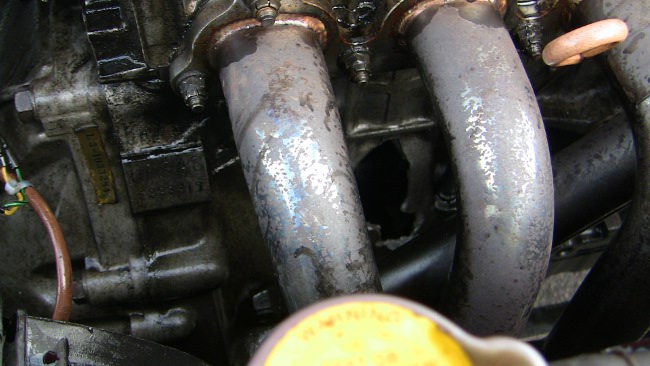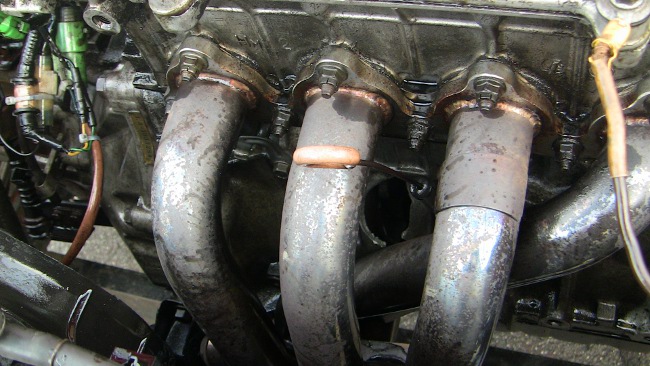Honda Civic ZC Block Ventilates
Published: August 28, 2014; updated: September 9, 2014
Last weekend at Pocono was a weekend of firsts. In the morning friction material on one of the Hawk DTC-60 brake pads separated from the backing plate. After figuring out that issue and I had the final session left which was on the full trioval. 6 laps into the final session the engine elected to ventilate itself.
I have experienced a variety of engine failures already:
- Running an engine out of oil at an autocross. Upon inspection, the engine had 1 quart out of 4 required. Result: bottom end noise, engine still ran. Bottom end was ruined but I am still using the head from this engine.
- Overheating an engine at Pocono, incidentally running one of the long courses. Result: engine shut down and would not start again, but stayed in one piece. Head was warped but remained usable, I reused the head from the first engine.
- Overboosting an engine. Result: engine developed top end tick, low oil pressure and low compression, still ran.
- Car would not start after parking after a number of flagpole races.
In all of the above failures the engine remained in one piece despite internal damage. I read about pistons and rods ejecting themselves from blocks but was not quite expecting this to happen to me:


Precursors
There were some warning signs leading up to the failure:
- The car was making at least three separate noises as of the first session of the event. One was a howl I attributed to brand new Nitto NT01 tires; I ran these tires before on my Miata and remembered that they howled when new. Another was a noise in right turns that did not occur in left turns or when driving straight; I attributed this to the left axle, as I noticed some play in the left front wheel. Finally there was a new noise that occurred above certain speed or RPM - I could not quite pinpoint it as I had no brakes most of the day and only ran a lap at a time in most sessions.
- Even before last weekend there was a brief noise that seemed like driveline noise at low RPMs, maybe 2-2,500.
- There was oil around the breather filter. I am not sure if this is related but I noticed the oil after Watkins Glen event.
- Right before I went out for the final session I noticed that my idle oil pressure was about 10 psi. The norm for the car was perhaps 50 psi, but Miata idles at 13 psi so 10 psi at idle was not sufficient reason for me to park the car. Regrettably I did not look at oil pressure once I went out and I have no data logger in the car to review oil pressure now that the engine exploded.
Possible Causes
Thinking about what may have caused this catastrophic failure, several possibilities come to mind.
At the previous Watkins Glen event I held the car at the redline for about 800 feet every lap. At 110 mph the car is traveling 200 feet per second, meaning I held the car at the redline for 4 seconds every 2.5 minutes.
At Pocono I spent most of the day working on the brakes but I was determined to run the final session on the trioval. Based on running the oval flat out in Miata I expected to run it flat out in Civic as well, and as such to not need brakes in the event they were still not fixed (I ended up having minimally acceptable brakes with some Hawk HP+ pads I still had). Further I expected to take the car to its top speed on the taller 205/55-14 tires and I actually wanted to see the car get to its top speed. I also wanted to get data for Civic on the trioval to compare against Miata.
At the Pocono trioval I reached the redline with the taller 205/55-14 tires on every straight, and was holding the car at the redline for much longer. About 10 laps into the session the engine blew up.
A cause for concern was the car using an undamped crank pulley. Most of the Internet wisdom suggests that undamped crank pulleys cause problems - oil pump destruction was the one I saw while researching pulleys for my Miata, and engine bearing destruction was something I came across while researching underdrive crank pulleys after the Pocono weekend.
An important factor in engine failures is oil, or lack thereof. Prior to the Pocono event I changed oil with Mobil 1 15w50. This is the heaviest recommended oil for the engine, one meant for highest ambient temperatures. As I barely drove the car at Pocono, oil should not have been the reason for engine destruction.
At the preceding Watkins Glen event I was at some point low on oil. However, I always saw good oil pressure, in the neighborhood of 50 psi, whenever I looked at the oil pressure gauge. That said, I obviously only looked at the oil pressure gauge sporadically.
Miata
Had this been my first time running the trioval, I might have concluded that cars cannot be held at redline for extended lengths of time. However, I have a perfect counterexample that proves that redline operation is possible - my Miata.
In 2012, just after Pocono was repaved, I ran the trioval with ACNA-NJ for an entire day. Most of the laps were spent close to the redline, yielding an estimated 1.5 hours of near-redline operation in one day.
Since then I ran events in which the final session was on the trioval twice in the Miata, with no damage to the car.
It seems that some engines can definitely handle being operated at near redline for a long time without exploding.
Takeaways
Engine health monitoring is important. Data logging is also very useful for post-mortem analysis of failures. Unfortunately I did not have data logging in the Civic. I am strongly considering installing a Racepak dash into the car, assuming I have it rebuilt.
Damped crank pulleys are important. I could have changed the crank pulley on the Civic, but did not. I will certainly not be replacing damped pulleys with undamped pulleys ones myself and I will try to avoid running cars with undamped pulleys.
I am not sure at this point if ZC or D series engines in general are tolerant of continuous high RPM operation.
Update: while researching replacement engines I came across this topic concerning D16A6's operation at rev limit. D16A6 has a redline of 6500 rpm and a rev limit of 7200 rpm; topics such as this one discourage taking D16A6 to 7200 rpm. Still, it appears that running D16A6 within the rev range permitted by the OEM ECU resulted in the engine failing.
Post-Mortem With Todd Reid
Todd Reid graciously offered me his thoughts on why my engine exploded:
-
Oil starvation at Watkins Glen - running low on oil at all is bad in Hondas, and I was quite low at Watkins Glen. Starving at high RPMs at high load on a race track is bad because it happens every lap - a half-second loss of oil pressure over 100 laps is 50 seconds of no oil. Not good.
Hondas especially are prone to starving in left turns, and Pocono trioval is an entirely left turn track. This probably explains rapid engine destruction on the trioval assuming oil starvation was happening.
Continuous high RPM operation - this is generally something that Honda engines apparently do not tolerate well.
Todd's suggestions to me were:
- Check oil level after each session, and run half a quart over full.
- Install a mechanical oil pressure gauge rather than an electric one, as a mechanical gauge will respond instantly and will show losses of oil pressure that last less than a second. I want to data log the oil pressure via a Racepak logger; Todd strongly advised me against using Auto Meter electric senders for oil pressure, instead recommending Racepak senders which react much faster.
- Install an oil temperature gauge - oil temperature of 300 F or greater is not good. I have no information on my oil temparatures in the Civic, although the car does have an oil cooler.
- Use a transmission which is geared to keep the engine under redline. Meaning a 5 speed transmission rather than a 4 speed one that I had.
 Visit our
Visit our